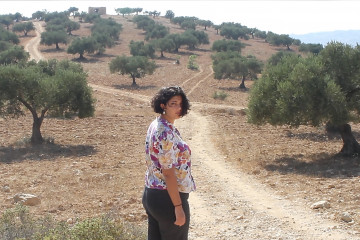

“I’m a performer, a singer, I’m used to seeing people’s reactions when I’m on stage, but it’s good to push boundaries beyond our location," begins Maya Al Khaldi.
"I’ve always been interested in doing things that are not happening in my place so that I can send these things out and they can have a life of their own,” she adds, speaking from Jerusalem.
Maya Al Khaldi is a musician, artist, and composer from Palestine, based in Jerusalem. She works with archival materials to imagine the future while exploring the voice and music of the past and present.
Commissioned by the Chapter Art Centre in Cardiff, her work is being shown in a new exhibition this month entitled Call the Waves, which is part of a multi-site programme located between Barry and Cardiff in Wales, Marrakech in Morocco, and Ramallah in Palestine.
"Maya’s work is about protecting these memories, the songs, and the life by the springs, about keeping them alive"
The project is supported by the Arts Council of Wales and Wales Arts International and co-curated by Francesca Masoero, Louise Hobson and Shayma Nader, for the platform SWAY.
Call the Waves is a collaborative project tethered to the hyper-tidal waters on the coast of South Wales.
It’s a group exhibition with a public programme that explores interconnected relationships with different bodies of water. Through underground waterways, springs, rivers and seas, artists, musicians, and historians propose to reclaim songs and stories, histories and futures.
“We began by thinking about tides and what happens when they leave,” explains Maya Al Khaldi. “I took this to my own metaphor. I’ve been working a lot with folk and traditional music, but also with archives. I’m interested in developing research from archives and anthropology. For this project, the curator approached me at the right time. She’s interested in similar issues, as she’s also an artist and a researcher.”
This curator, Shayma Nader, was born in Jerusalem and now lives and works in Ramallah, Palestine. “With the two other curators, we wanted to explore the themes of poetics of waters in different localities, including Wales, Morocco, Egypt and Palestine,” she told The New Arab.
“That’s the goal of the SWAY platform. We want to connect these separate geographies through intimate stories about water. The selection of artists came from personal friendships; we enjoy their work.”
Right away, Maya and Shyama thought about songs related to water. “Because our history and culture have been so violently interrupted and invaded in Palestine, we all have the need to reconnect with it,” Maya said.
“So, when asked: ‘how was it when the tides were there?’ I decided to go to a spring known as the Maqam al-Nabi Ayoub, a holy place where the prophet Ayoub is said to have healed his sickness with the waters.” The spring is in the small village of Ras Karkar, west of Ramallah.
"Because our history and culture have been so violently interrupted and invaded in Palestine, we all have the need to reconnect with it"
“There is a shrine for the prophet near the spring there,” Maya continued, “and when I went, I met a woman who lives nearby and shared many stories with me – from her mother, from their habits of fishing and their relation to the waters. She was so lovely to me. But she also spoke about what they’ve been through because of the Israeli army. I asked her to teach me their songs, and my goal became to carry them forward.”
The spring, now locked because of the constant pressure of the Israeli army, was once a source for communal washing, drinking, and healing. With her singing, Maya “reimagines the time when the water was flowing.”
Maya’s work is about protecting these memories, the songs, and the life by the springs, about keeping them alive.
The songs tell stories of displacements, like the other works in the exhibition. “Yet I didn’t want to only preserve the old songs,” she added.
“I want to add my own reflection. I created four pieces of music, and each one has a different perspective on the site I visited, the stories the site keep lady told me.”
Maya sings in Arabic on three of them; the fourth one is instrumental.
She used sound recordings and manipulated them electronically. The result is between songs and narratives, broadcast in the spaces of the exhibition.
The voices sound like they’re coming from inside the spring, according to the curator, Shayma: “It’s about connecting, and about the meaning of what comes after the waters have run.”
Maya most recently released her first solo album, Other World, “a record of folklore Palestinian music, based on audio-only archives from the 1980s, from traditional music,” according to the artist.
She also teaches music theory and voice at the Edward Said national conservatory in Jerusalem, Palestine, works with a Terre Des Hommes project and continues her PhD.
Melissa Chemam is a French-Algerian freelance journalist and culture writer based between Paris, Bristol and Marseille, and travelling beyond.
Follow her on Twitter: @melissachemam





 Follow the Middle East's top stories in English at The New Arab on Google News
Follow the Middle East's top stories in English at The New Arab on Google News


